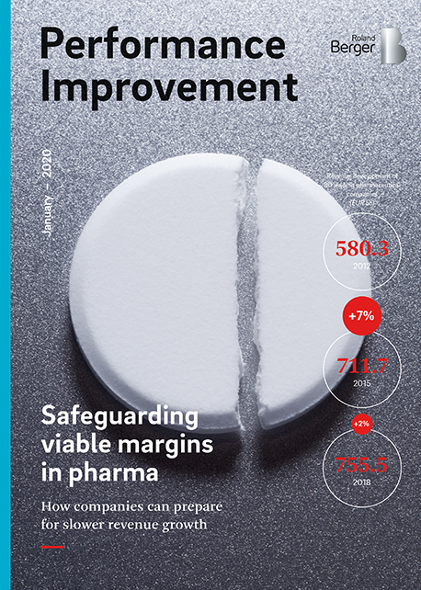Performance Improvement: How pharma businesses can safeguard viable margins
![{[downloads[language].preview]}](https://www.rolandberger.com/publications/publication_image/RB_STU_607_Performance_Improvement_cover_download_preview.png)
Pharmaceutical companies increasingly face performance pressure as revenue growth is slowing down. What can they do to ensure their long-term sustainability?


"The concept of adequacy puts an alignment and update of the organizational hardware and software ahead of the improvement via effectiveness and efficiency."
Pharmaceutical companies face ever-increasing pressure as revenue growth slows down. This leads to the pharmaceutical blockbuster model being challenged by personalized therapies and smaller patient populations.
Pharmaceuticals companies must operate more effectively and efficiently. As high-margin businesses, drug makers have traditionally seen performance improvement as a less pressing response to declining sales margins. Rather than managing costs, companies were able to increase revenues as an antidote to margin pressures. A new round of investment in research and development or business development and licensing typically delivered new high-margin products, boosting sales and profitability. But this top-line growth trick is becoming more elusive. A Roland Berger analysis of 80 leading publicly listed pharma companies – representing about 70% of the market – shows that annual revenue growth fell by more than two thirds in the last three years.
Pharma companies' traditional response to eroding margins has come under pressure in recent years. Healthcare systems all over the world have striven to better control expenditure. While drug development can target individual patients much more effectively today, it has become ever more difficult to create blockbuster drugs to serve broader patient populations. These targeted developments often require more complex manufacturing processes, which require end-to-end process control and effective steering of cost of goods sold (COGS).
"A performance improvement initiative is a great opportunity to take stock of often overloaded and expensive project portfolios and declutter the organization to save money, free crucial resources and embark on an optimization journey. "
The maintaining of high profitability is of vital importance to all pharmaceutical manufacturers. High margins allow them to fund the next cycle of investment in new drugs and to play an active role in industry consolidation. Even only slowly declining margins signal declining market share in the future, and declining investment funding and acquisition power today. Companies caught in this downward spiral must invest time management and resources to conceive and implement performance improvement measures.
This shift from pursuing revenue growth to achieving cost improvements demands a new corporate mindset. Executives running high-margin businesses like drug companies are typically used to dealing with long-term investment strategies, rather than short- to mid-term performance improvement programs. They are often not used to broadly addressing cost issues, and this is compounded by the fact that weakening margins tend to erode slowly – communicating and justifying painful measures is hard. To overcome this double difficulty, pharmaceutical executives can build on the proven Roland Berger framework to help master three crucial elements essential to performance improvement:

![{[downloads[language].preview]}](https://www.rolandberger.com/publications/publication_image/RB_STU_607_Performance_Improvement_cover_download_preview.png)
Pharmaceutical companies increasingly face performance pressure as revenue growth is slowing down. What can they do to ensure their long-term sustainability?